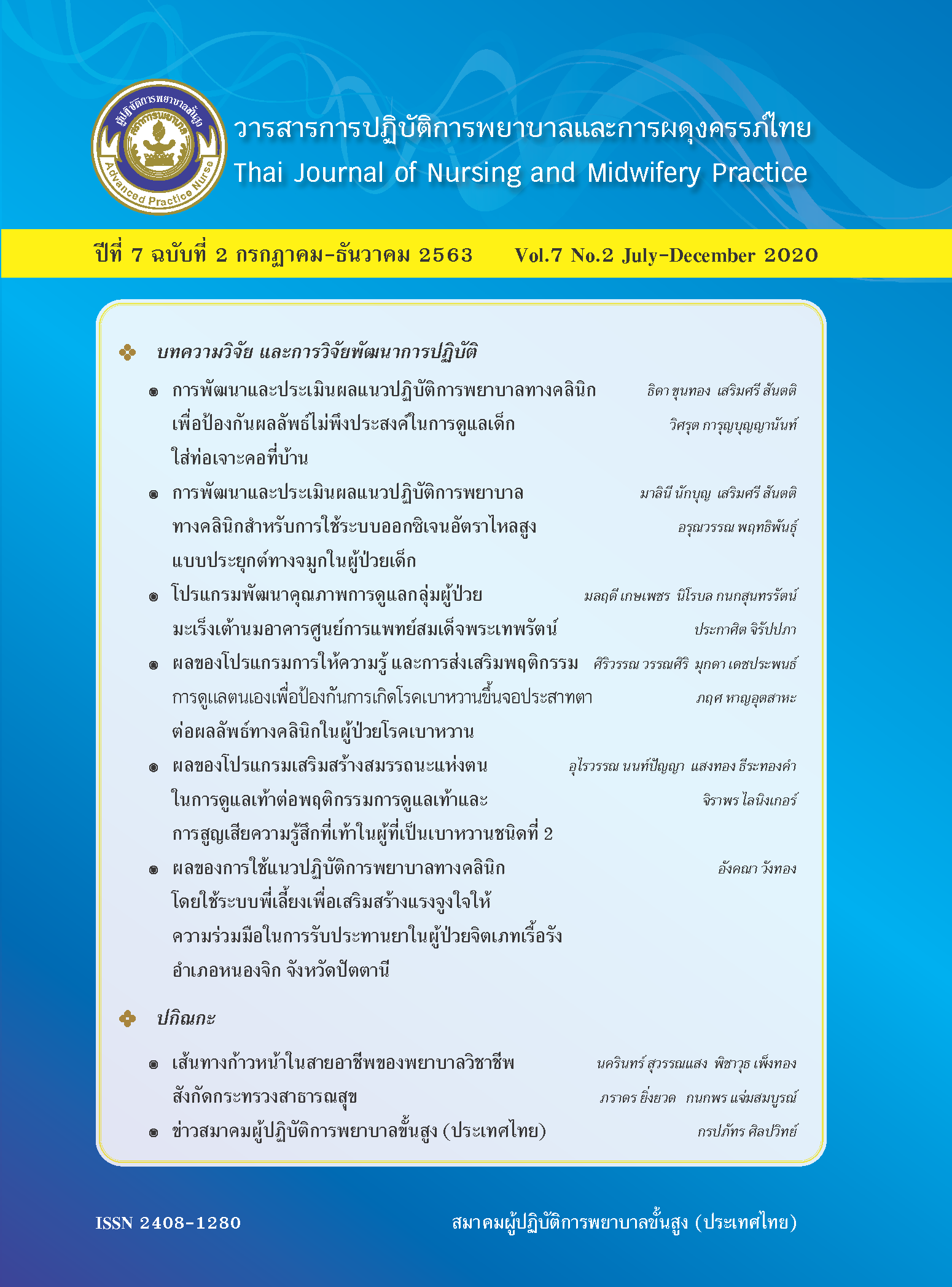Development and Evaluation of Clinical Nursing Practice Guideline to Prevent Undesirable Outcomes in Caring for Children with Tracheostomy Tube at Home
Main Article Content
Abstract
Taking care of children with tracheostomy tube at home is a difficult and complicated situation. Development and use of clinical nursing practice guideline could standardize the care, as well as prevent undesirable outcomes. This research aimed to: (1) develop clinical nursing practice guideline in caring for children with tracheostomy tube at home using evidence based practice; (2) assess the feasibility in implementing the guideline; and (3) evaluate the outcomes of clinical nursing practice guideline implementation. The samples were 29 nurses and case studies of caregiving for children with tracheostomy tube. Data collection tools developed by the researchers were: the feasibility assessment form and questionnaire on satisfaction of nurses using the guideline; and the case study recording form. Data were analyzed by descriptive statistics and content analysis. Results showed that: (1) the developed practice guideline was based on 80 evidences and consisted of 3 stages: before discharge; preparing for discharge; and after discharge. The guideline was examined be 3 experts. The content validity for the scale/average (S-CVI/Ave) was 0.99 and for S-CVI/UA was 0.98; (2) the feasibility of the guideline was reported at the high level (Mean = 61.2; SD = 6.59); and (3) the evaluation of the guideline implementation from 27.6% of nurses reported at high satisfaction level (Mean = 4.25; SD = 0.46). The undesirable outcome reported from the case study was the tracheostomy tube slipped off. However, the caregiver could manage the situation without being back to the hospital. The developed clinical nursing practice guideline could help caregiver in caring for the child with tracheostomy tube at home safely. The guideline should be further monitored and evaluated.
Downloads
Article Details
References
เอกสารอ้างอิง
Watters KF. Tracheostomy in infants and children. Respir Care 2017;62(6):799-825.
Oberwaldner B, Eber E. Tracheostomy care in the home. Paediatr Respri Rev 2006;7(3):185-190.
Baker CD, Martin S, Thrasher J, Moore H, Baker J, Abman SH, et al. A standardize discharge process decreases length of stay for ventilator-dependent children. Pediatrics 2016;137:e1-9.
Preutthipan A, Nugboon M, Chaisupamongkollarp T, Kuptanon T, Kamalaporn H, Leejakpai A. An economic approach for children with chronic ventilation support. Curr Pediatr Rep 2014;2:1-8.
Rafferty A, Knight D, Bew S, Knigh L. Retrospective cross-sectional review of delayed discharge after pediatric tracheostomy. The Journal of Laryngology & Otology 2012;126:1247-1253.
Preutthipan A. Home Mechanical ventilation in children. Indian J Pediatr 2015;82:852-859.
Ligoski Dal, Astra AP, Quirino AV, Alves de Sousa Caixeta J, Gomes Avelino MA. Tracheostomy in childhood: review of the literature on complications and mortality over the last three decades. Braz J Otarhinolaryngol 2017;83:207-214.
Funamura JL, Yuen S, Kawai K, Gergin O, Adil E, Rahbar R, et al. Characterizing mortality in pediatric tracheostomy patients. Laryngoscope 2017;127:1701-1706.
Sritipayawan S, Deerojanawong J, Prapphal N. Clinical guideline for respiratory therapy in pediatrics.
Pediatric Lung Club of Thailand. The Royal College Pediatrics Physicians of Thailand. Nonthaburi:Beyond
Enterprise Company; 2010.(In Thai)
Tearl DK, Cox TJ, Herzong JH. Hospital discharge of respiratory-technology-dependent children: role
of a dedicated respiratory care discharge coordinator. Respiratory Care 2006;51:744-749.
Sodhi K, Shrivastava A, Singla MK. Implications of dedicated tracheostomy care nurse program on outcomes. J Anesth 2014;28:374-380.
Jackson MF. Discharge planning: issues and challenges for gerontological nursing. A critique of
the literature. Journal of Advanced Nursing 1994;19:492-502.
Overholt E, Jhonson L. Teaching EBP: Asking searchable, answerable clinical questions. Worldviews
on Evidence-Based Nursing Journal 2005; 2(3): 157-60
The Royal College Physicians of Thailand. Recommendation for develop clinical practice guidelines. Royal College Physicians of Thailand Bulletin 2001;18(16):36-47. (In Thai)
Polit DF, Hungler BP. Nursing research: Principle and methods. 6thed. Philadelphia: Lippincott;1999.
Chen CH, Chang JH, Hsu CH, Chiu NC, Peng CC, Jim WT, et al. A 12 year experience with tracheostomy for neonate and infants in Northern Taiwan: Indications, hospital courses, and long-term outcomes. Pediatr Neonatal 2018;59:141-146.
Aveleno MA, Maunsell R, Velera FC, Neto J, Schweiger C, Miura CS, et.al. First clinical consensus and national recommendations on tracheostomized children of the Brazillian Academy of Pediatric Otorhinolaryngology (ABOPe) and Brazillian Society Pediatric (SBP). Braz J Otorhinolaryngol 2017; 83: 498-506.
Deerojanawong J. Oxygen therapy. In Sritippayawan S, Deerojanawong J, Prapphal N, editors. Respiratory therapy guideline in children; 2013. (In Thai)
Wetzel RC. Anesthesia for pediatric trauma. In: Stane JK, Grande CM, editors. Trauma anesthesia. Baltimore:
William & Wilkins;1991.
Zia S, Arshad M, Nazir Z, Awan S. Pediatric tracheostomy: complications and role of home care in a developing country. Pediatric Surgery 2010; 26:269-273.
Moreno L, Peck JL. Nurse practitioner - led telehealth to improve outpatient pediatric tracheostomy management in South Texas. Journal Pediatric Health care 2020; 34:246-255.


